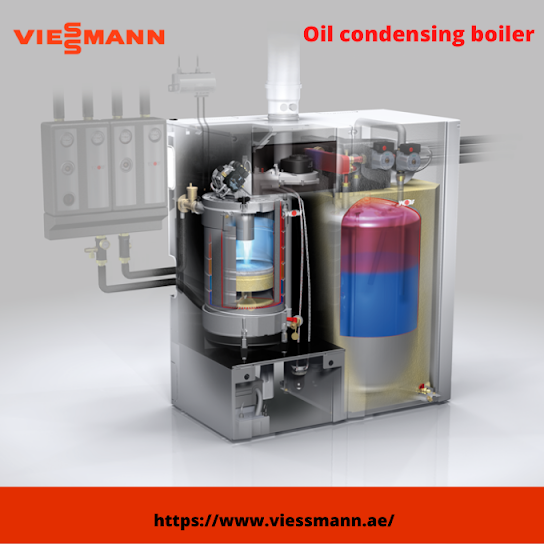Oil Condensing Boiler – UAE – Viessmann.ae
Viessmann are the Condensing boilers now represent the most advanced technology in the field of boilers. At present, their performance is almost entirely based on natural gas, which contains methane (more than 95% of the volume in the composition). If natural gas is not available - for example when there is no access to a natural gas network - another common alternative is LPG. Liquid fuel is also considered in other studies.
Energy efficiency through the steam heat of flue gas is analyzed on paper to detect seven other fuels - butane, propane, coal gas, biogas, heavy oil, diesel and natural oil - and the fuel that it is methane. The greenhouse effect of these fuels is also being analyzed. Studies show that biogas provides much higher energy-saving technologies for thickening (even more than methane) while heavy oil has much lower energy. CO2 emissions tests show that coal gas has a significant greenhouse effect.
The results of the flexible computational fluid showed the thermal conductivity values of stainless steel, a common temperature changer, do not need to be achieved with the same thermal transfer function. An increase in thermal efficiency from about 10 times that of a basic polymer can achieve the optimal heat transfer efficiency with that obtained from stainless steel.
A
polymer composite thermal conductivity of approximately 2.5 W/mw would be adequate. Thermally
conductive polymer materials are now commercially available which offer values
up to 20 W/mw. In this work, a single
Nylon-12 and thermally conductive polymer composite heat exchanger prototypes
were developed for use in dual boiler. Studies have shown that the overall
efficiency of heat transfer is achieved. The low thermal conductivity of the
polymer temperature switch will result in higher temperatures and lower levels
of water vapor.
Lack
of reliable methods of calculating the heat transfer of convex water vapor
emissions from high-pressure gases with a high content of non-volatile gases on
the surface of contaminants in outgoing gas boilers with water-fuel emulsion
(WFE) requirements theory and experiments. Experimental researches of pollution
intensity at wall temperatures below dew point of sulfuric acid vapors were
carried out on Based on theater data to assess the relative coefficient of WFE
pollution, wall temperature, gas speed, pipe diameter and piping steps have
been performed.
The retrospective figure makes it possible to estimate the impact of various factors such as WFE water content, wall temperature and gas velocity on the coefficient of pollution. Analysis of the study results showed that WFE heating by 30% water reduces the level of contamination of the heating coefficient and increases the cleaning time. The values obtained by the coefficients of pollution can be used in the construction and operation of heat-insulating boilers.
Viessmannare the Analysis of the literature has shown a lack of data on ground pollution, heat transfer, and efficient thermal coefficients to achieve a flammable surface of the water-energy emulsion. The study aimed to determine the dependence of heat transfer coefficients, contaminants, and thermal efficiency from wall temperature to minimize low temperatures. Pollution experiments have been performed on experiments with petroleum and fossil fuel emulsion. In a capillary-porous wet body, as well as heat transfer in the form of heat, energy is transferred due to the mass transfer. It is necessary to consider the availability of internal heat sources because, in the layer, there is an increased amount of heat due to the passage of absorption processes and the reaction of chemical reactions.
The dependence of heat transfer coefficients, impurities, and thermal efficiency from wall temperature has been improved based on experimental-theory data. The results analysis showed that water-fuel emulsion heating with a water content of 30% increased heat transfer and periodic cleaning of hot surfaces. It is recommended to reduce the length of time between cleaning to 8 hours for maximum heat transfer efficiency and optimal heat transfer efficiency. The reliability of the detected coefficients of greenhouse gas emissions is recommended to be used in the standard method of calculating the flexible temperature of the exhaust gas boiler.
Analysis of the literature has shown a lack of data on ground pollution, heat transfer, and efficient thermal coefficients to achieve a flammable surface of the water-energy emulsion. The study aimed to determine the dependence of heat transfer coefficients, contaminants, and thermal efficiency from wall temperature to minimize low temperatures.
Pollution
experiments have been performed on experiments with petroleum and fossil fuel
emulsion. In a capillary-porous wet body, as well as heat transfer in the form
of heat, energy is transferred due to the mass transfer. It is necessary to
consider the availability of internal heat sources because, in the layer, there
is an increased amount of heat due to the passage of absorption processes and
the reaction of chemical reactions.
The
dependence of heat transfer coefficients, impurities, and thermal efficiency
from wall temperature has been improved based on experimental-theory data. The
results analysis showed that water-fuel emulsion heating with a water content
of 30% increased heat transfer and periodic cleaning of hot surfaces. It is
recommended to reduce the length of time between cleaning to 8 hours for
maximum heat transfer efficiency and optimal heat transfer efficiency. The
reliability of the detected coefficients of greenhouse gas emissions is
recommended to be used in the standard method of calculating the flexible
temperature of the exhaust gas boiler.

Comments
Post a Comment